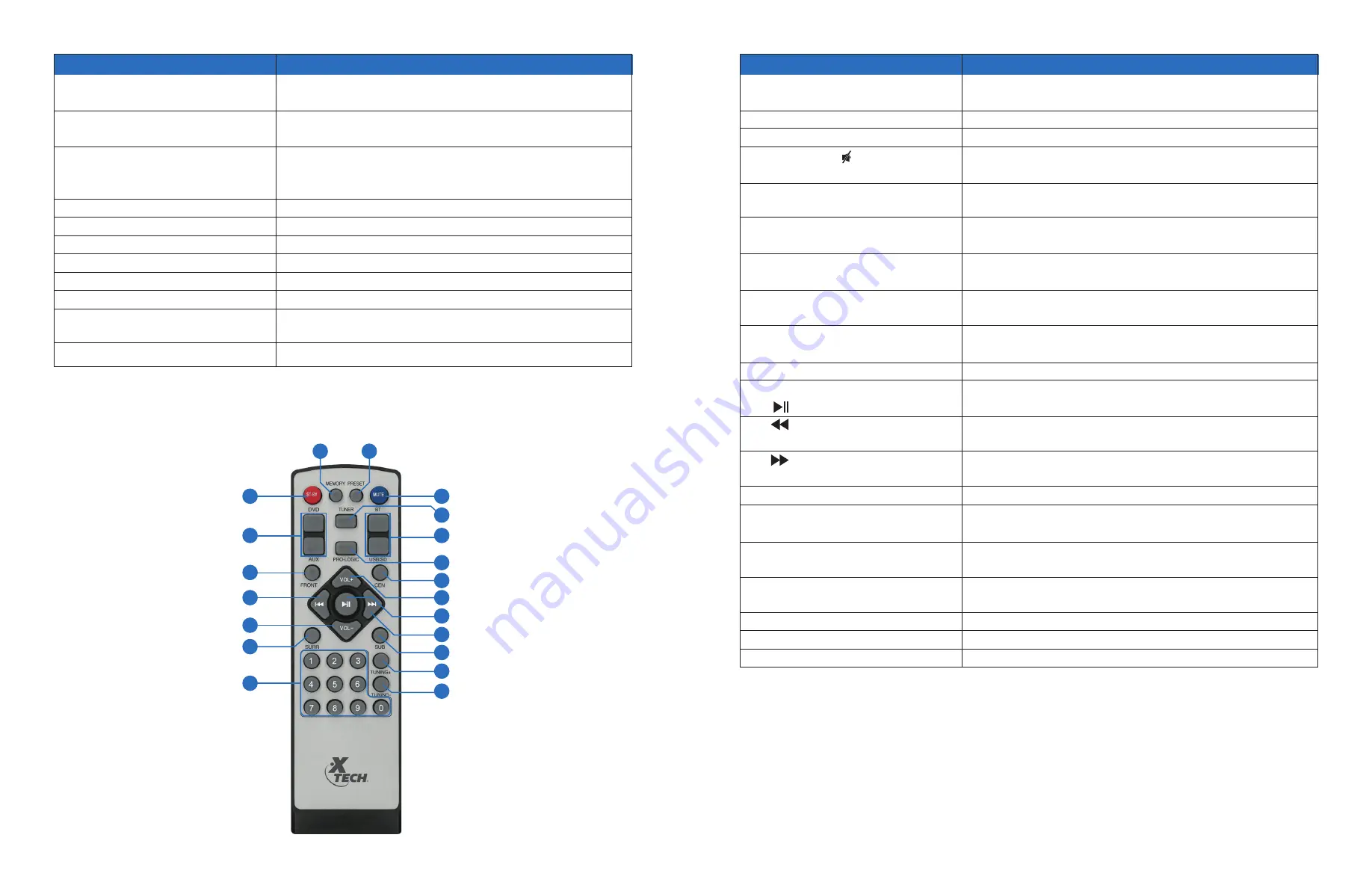
1
5
8
12
17
14
15
4
7
6
9
10
2
3
11
16
13
18
19
20
Remote control
Connectors
1. AUX input
2. DVD inputs
3. Speaker output connections
3.1 FR
3.2 FL
3.3 SR
3.4 SL
3.5 CEN
4. Main power switch
5. Voltage selector switch
6. AC power cord
Description
These RCA jacks allow the connection of audio devices fitted
with a 3.5mm plug.
Provides the connection of additional audio components
with full 5.1 channel capability
Connect all five satellites in this jack block, matching the
label of each speaker with the corresponding connectors on
the main unit.
The front right speaker must be connected here.
The front left speaker must be connected here.
The surround (rear) right speaker must be connected here.
The surround (rear) left speaker must be connected here.
The center speaker must be connected here.
Turns the speaker on and off.
Select 110V or 220V to match the utility voltage used in your
area.
Insert the power cord plug in an AC outlet.
Buttons
1. Standby button
2. Memory button
3. Preset button
4. Mute button
5. DVD/Aux button
6. Pro Logic
7. Bluetooth® and USB/SD™ button
8. Front button
9. Center button
10. Vol +
11.
12.
13.
14. Vol -
15. Surround button
16. Subwoofer button
17. Numbered keypad
18. Tuning + button
19. Tuning - button
20. Tuner
Description
Press this button to alternate between the standby and
active modes on the device
Press it to store your favorite channels for quick recall
Use it to call memorized channels
Cancels the audio coming from the speaker. Press it again to
unmute the speaker
Toggles the input mode between these two RCA wired
connections
This button switches the decoder between 2.1 and 5.1 audio
channels
Toggles the input mode between the wireless connection
and digital storage devices.
Selects the front speaker to adjust its output level
individually using the volume keys.
Selects the central speaker to adjust its output level
individually using the volume keys.
Increases the volume level coming from the speaker system
Press to start and pause media during
Bluetooth®
, SD™ or
USB audio playback.
Takes you back to the previous track on your play list.
Available in
Bluetooth®
, SD™ and USB modes.
Takes you to the next track on your play list. Available in
Bluetooth®
, SD™ and USB modes
Lowers the volume level coming from the speaker system
Selects the surround (rear) speaker to adjust its output level
individually using the volume keys
Selects the subwoofer speaker to adjust its output level
individually using the volume keys
Press any key from 0 to 9 on the remote to choose directly
the tracks or channels you want to play.
Press it to scan memorized channels in an upward direction.
Press it to scan memorized channels in a downward direction.
This button enables the tuner mode.
III. Initial setup
1. Start by verifying the AC input on the back of the main unit. Choose 110V or 220V
according to the mains power available in your area.
2. Then, install the two AAA supplied batteries inside the remote control.
3. Next, connect the front, center and rear satellite speakers to the corresponding output
connectors on the back of the main unit.
4. Connect the left (red) and right (white) RCA plugs into the matching input jacks on the
back of the main unit for wired playback from audio devices fitted with a 3.5mm stereo
connection. Proceed to connect an external audio device, such as a laptop, television set,
MP3/4 player, smartphone or tablet.
5. In addition, the DVD inputs let users enjoy multichannel surround sound, through the
use of the subwoofer and the five satellites (two front and two rear speakers, plus one center
speaker). Audio RCA cables are required to do the connections, which are not supplied.
When connecting RCA cables, make sure to match the color coded pins to the appropriate
jacks on the component being used as a source.
6. Once all the speakers and audio components have been properly connected, plug the
AC cord of the speaker system into a wall outlet.
7. Turn on the speaker by changing the main power switch on the back of the unit to its
ON position. After that, the user can also press the red standby button on the remote control
to toggle between active and standby modes.
8. Select the input mode by pressing the source selector button located on the front of
the main unit or by using the corresponding input buttons on the remote control. The
available modes are:
USB: enables audio playback from compatible files stored in a USB memory stick
SD™: enables audio playback from compatible files stored in a SD™ memory card
Bluethooth®: enables the streaming of audio wirelessly from compatible
Bluetooth®
devices
Aux: enables audio playback from devices fitted with an auxiliary 3.5mm jack
DVD: additional input enables the connection of audio components with full 5.1
channel capability
Tuner: allows you to listen to active channels in the band
Note: please remember that some commands will not be active or behave differently
in both line in modes (refer to the product diagram for details).
9. Using the controls on the front of the main unit or the remote, you can manage and
select your tracks, mute the speaker audio, in addition to adjusting the the output levels of
each channel individually.
10. If you do not intend to use the speakers for a long time, set the power switch to its
OFF position.
IV. Advanced operation
Pairing the speaker with your wireless device
1. Place both devices not more than one meter away from each other.
2. Enable the
Bluetooth®
function on your device and set it to discover the XTS-450
wireless speaker.
3. When you turn on the speaker, it defaults to
Bluetooth®
mode. In case the speaker is set to a
different mode, press the Source button on the main unit or the remote control to select
this feature.
4. At this point, two short beeps will be generated, making the blue dot on the display start
blinking fast. This indicates that the system has entered into the pairing mode.
5. Once the speaker is listed under the newly found
Bluetooth®
devices, accept by pressing
Yes or OK. If you have a lower
Bluetooth®
version, you may be prompted to enter
the passkey 0000 (4 zeros).
6. If pairing is successful, another short beep will be heard, making the dot on the LED
change to steady blue on the speaker screen. On your device, a confirmation message
will be displayed, confirming that the connection has been established.
7. If after 60 seconds the pairing process fails, please repeat steps 1 through 5 described
above.
8. From then on, your device will be automatically paired with the speaker.
V. Multichannel surround setup
In order to get the best perfomance from your audio system, the optimum location for the
speakers needs to be determined.
Most DVDs and many streaming sources come with a 5.1 channel format, which is fully suppor-
ted by this system.
5.1 channel system setup
• Front left and right speakers (FL and FR):
Place speakers at ear height, ideally producing a 45 degree angle as viewed from the main
seating position. This delivers a wide sound stage and precise localization of individual sounds.
• Center channel speaker (CEN):
The center channel speaker should be placed between the front right and left speakers,
forming an arc (not a straight line), and at an equal distance from your listening position. If
connecting the system to a TV, this can be installed either above or below the set.
• Surround left and right speakers (SL and SR):
The rear speakers (surround channels) should ideally be placed at the same distance from your
listening position as the front speakers, at an angle between 90 to 110 degrees from the front of
the center speaker. Position these speakers slightly to the rear of (but not behind) the listening
position, preferably 1 meter above ear height.
• Subwoofer (Sub):
Since bass frequencies are not very “directional”, placing the subwoofer under the desk or to the
left or right of the room will be fine.



























